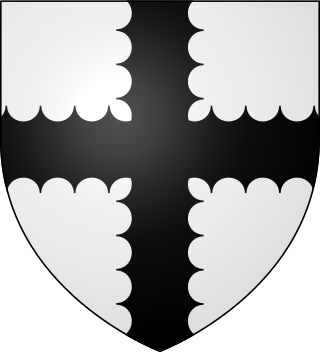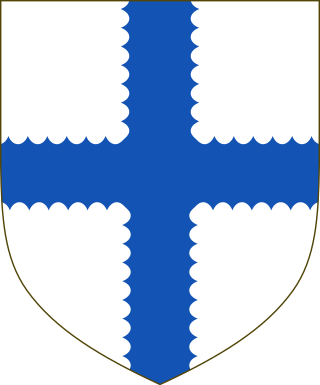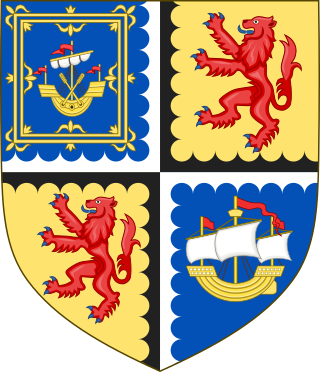
Henry I Sinclair, Earl of Orkney, Lord of Roslin was a Scottish noblesse. Sinclair held the title Earl of Orkney and was Lord High Admiral of Scotland under the King of Scotland. He was sometimes identified by another spelling of his surname, St. Clair. He was the grandfather of William Sinclair, 1st Earl of Caithness, the builder of Rosslyn Chapel. He is best known today because of a modern legend that he took part in explorations of Greenland and North America almost 100 years before Christopher Columbus. William Thomson, in his book The New History of Orkney, wrote: "It has been Earl Henry's singular fate to enjoy an ever-expanding posthumous reputation which has very little to do with anything he achieved in his lifetime."
William Sinclair (1410–1480), 1st Earl of Caithness (1455–1476), last Earl (Jarl) of Orkney, 2nd Lord Sinclair and 11th Baron of Roslin was a Norwegian and Scottish nobleman and the builder of Rosslyn Chapel, in Midlothian.

Rosslyn Chapel, formerly known as the Collegiate Chapel of St Matthew, is a 15th-century chapel located in the village of Roslin, Midlothian, Scotland.

Lord Sinclair is a title in the Peerage of Scotland. According to James Balfour Paul's The Scots Peerage, volume VII published in 1910, the first person to be styled Lord Sinclair was William Sinclair, 3rd Earl of Orkney and 1st Earl of Caithness. However, according to Roland Saint-Clair writing in the late 19th century, William Sinclair's father, Henry II Sinclair, Earl of Orkney, who died in 1420, is the first person recorded as Lord Sinclair by public records.

Clan Sinclair is a Highland Scottish clan which holds the lands of Caithness, the Orkney Islands, and the Lothians. The chiefs of the clan were the Barons of Roslin and later the Earls of Orkney and Earls of Caithness.

Roslin Castle is a partially ruined castle near the village of Roslin in Midlothian, Scotland. It is located around 9 mi (14 km) south of Edinburgh, on the north bank of the North Esk, only a few hundred metres from the famous Rosslyn Chapel.

Baron of Roslin or Rosslyn was a Scottish feudal barony held by the St Clair or Sinclair family.

William St Clair of Roslin, 20th Baron of Roslin (1700-1778) was a member of the Clan Sinclair. His title, Baron of Roslin, was not a peerage but a Scottish feudal barony. He had an interest in sport and was a skilled golfer and archer. He redesigned the Old Course at St. Andrews to 18 holes thus affecting all golf courses since. He was the son of Alexander St Clair, 19th Baron of Roslin.

Sir Henry St Clair was a 13th- and 14th-century Scottish noble, who was the 7th Baron of Roslin and Lord of Catcune.

George Sinclair was a Scottish nobleman, the 4th Earl of Caithness and chief of the Clan Sinclair, a Scottish clan of the Scottish Highlands.

William St. Clair, 6th Baron of Roslin was a Scottish nobleman of the late 13th century.

William Sinclair of Newburgh, Aberdeenshire was a Scottish nobleman and the 3rd Lord Sinclair. In The Scots Peerage by James Balfour Paul he is designated as the 2nd Lord Sinclair, but historian Roland Saint-Clair designates him the 3rd Lord Sinclair in reference to his descent from his grandfather, Henry II Sinclair, Earl of Orkney, the first Lord Sinclair. Roland Saint-Clair references this to an Act of the Scottish Parliament in which William Sinclair's son, Henry Sinclair, 4th Lord Sinclair, was made Lord Sinclair based on his descent from his great-grandfather, Henry II Sinclair, Earl of Orkney, the first Lord Sinclair. Bernard Burke, in his a Genealogical and Heraldic Dictionary of the Peerage and Baronetage of the British Empire, agrees with Roland Saint-Clair and says that Henry Sinclair was "in reality" the fourth holder of the title of Lord Sinclair.

Oliver St Clair was a Scottish noble and the 12th Baron of Roslin.

William St Clair was a Scottish noble and the 13th Baron of Roslin.

William St Clair was a Scottish nobleman and the 14th Baron of Roslin.

William St Clair was a Scottish nobleman and the 15th Baron of Roslin.

John St Clair was a Scottish nobleman and the 17th Baron of Roslin.

James St Clair was a Scottish nobleman and the 18th Baron of Roslin.

John Sinclair was a Scottish nobleman and the 10th Lord Sinclair. In The Scots Peerage by James Balfour Paul he is designated as the 9th Lord Sinclair in descent starting from William Sinclair, 1st Earl of Caithness and 3rd Earl of Orkney, but historian Roland Saint-Clair designates him as the 10th Lord Sinclair in descent from the father of the 1st Earl of Caithness and 3rd Earl of Orkney, Henry II Sinclair, Earl of Orkney, who is the first person recorded as Lord Sinclair in public records. Roland Saint-Clair references this to an Act of the Scottish Parliament in which the 4th Lord Sinclair was made Lord Sinclair based on his descent from his great-grandfather, Henry II Sinclair, Earl of Orkney, the first Lord Sinclair. Bernard Burke, in his a Genealogical and Heraldic Dictionary of the Peerage and Baronetage of the British Empire, agrees with the numbering by Roland Saint-Clair and says that Henry Sinclair and William Sinclair were "in reality" the fourth and fifth Lords Sinclair respectively.

Lord Herdmanston was a title in the Peerage of Scotland that was held by the Sinclair or St Clair family.







